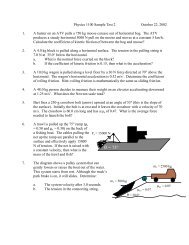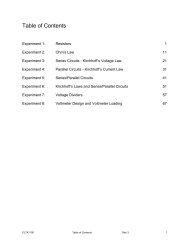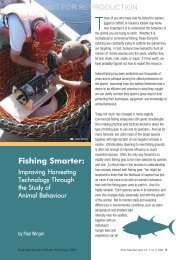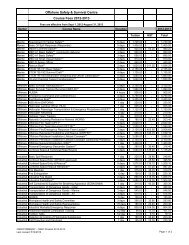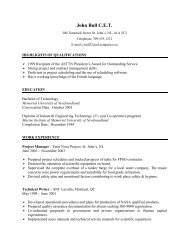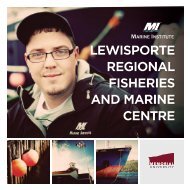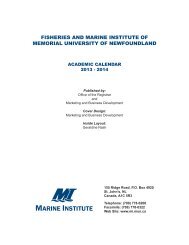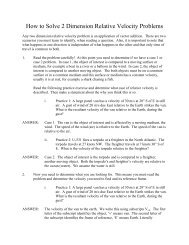Hybrid Marine Propulsion on the Tugboat Carolyn Dorothy
Hybrid Marine Propulsion on the Tugboat Carolyn Dorothy
Hybrid Marine Propulsion on the Tugboat Carolyn Dorothy
Create successful ePaper yourself
Turn your PDF publications into a flip-book with our unique Google optimized e-Paper software.
adding additi<strong>on</strong>al parts to <strong>the</strong> existing propeller,<br />
servicing of <strong>the</strong> existing blades, and/or<br />
developing better propulsi<strong>on</strong> technology.<br />
istockphoto.com/davelogan<br />
Figure 6: A bulbous bow is a tubular shaped piece protruding from<br />
<strong>the</strong> stem of a ship that changes <strong>the</strong> hydrodynamics of a moving<br />
vessel. Developed by David Wats<strong>on</strong> Taylor in 1910, <strong>the</strong> design has<br />
been developed and streamlined to provide optimum performance<br />
for a ship.<br />
Willem vanmaanen www.wellandcanal.ca<br />
Figure 7: Bow wave created by a c<strong>on</strong>tainer ship. Less resistance<br />
means a smaller wake and an easier passage through water.<br />
The bulbous bow can reduce fuel c<strong>on</strong>sumpti<strong>on</strong><br />
by approximately 12 to15% (dependent <strong>on</strong> <strong>the</strong><br />
underwater hull design of <strong>the</strong> ship) <strong>on</strong> ships<br />
that achieve speeds of more than six knots. In<br />
certain cases, as much as 25% reducti<strong>on</strong> of<br />
power has been observed. There are <strong>on</strong>ly two<br />
disadvantages. First, when <strong>the</strong> vessel is travelling<br />
at lower speeds, <strong>the</strong> bulb can hinder <strong>the</strong> ship’s<br />
performance by creating more wetted surface,<br />
which adds drag. Sec<strong>on</strong>d, if <strong>the</strong> ship sets its<br />
anchor from <strong>the</strong> stem, <strong>the</strong> anchor may hit <strong>the</strong><br />
bulb <strong>on</strong> its descent, or <strong>the</strong> anchor rope may<br />
chafe <strong>on</strong> <strong>the</strong> bow.<br />
Propeller arrangements<br />
The propeller is an important comp<strong>on</strong>ent of<br />
<strong>the</strong> propulsi<strong>on</strong> system of a ship. Therefore,<br />
any improvements that will help to reduce <strong>the</strong><br />
c<strong>on</strong>sumpti<strong>on</strong> of fuel are desirable. Innovative<br />
approaches include reblading of propellers,<br />
Reblading of Propellers<br />
When a vessel is first built, it is fitted with<br />
propellers of <strong>the</strong> most advanced design in that<br />
current period. A vessel has a service life of<br />
about 25 years and, during this time,<br />
manufacturers will have improved <strong>the</strong>ir designs<br />
and improved <strong>the</strong>ir abilities to build more<br />
efficient propellers. The advance in propeller<br />
design corresp<strong>on</strong>ds to <strong>the</strong> operating changes<br />
of <strong>the</strong> vessel. Optimum vessel performance<br />
can be maintained by reblading <strong>the</strong> propeller<br />
to <strong>the</strong> more modern and effective versi<strong>on</strong>.<br />
Rolls-Royce has underg<strong>on</strong>e several reblades of<br />
vessels resulting in “substantial reducti<strong>on</strong>s in<br />
fuel c<strong>on</strong>sumpti<strong>on</strong> and a short payback time.”<br />
The short payback time is an attractive quality<br />
making reblading a cost-effective soluti<strong>on</strong>.<br />
The first reblading Rolls-Royce undertook<br />
was in 2005 <strong>on</strong> <strong>the</strong> Stena Germanica, which<br />
operates <strong>on</strong> <strong>the</strong> Go<strong>the</strong>nburg-Kiel route. The<br />
results of <strong>the</strong> upgrade have been successful.<br />
“The increase in fuel efficiency has turned out<br />
to be about 10% … additi<strong>on</strong>al advantages to<br />
<strong>the</strong> customer are that <strong>the</strong> level of redundancy<br />
is increased and maintenance costs are cut.”<br />
Subsequently, Rolls-Royce rebladed two more<br />
Stena ferries: <strong>the</strong> Trelleborg (fuel c<strong>on</strong>sumpti<strong>on</strong><br />
reduced by 10 to 12%) and Stena Nordica (fuel<br />
c<strong>on</strong>sumpti<strong>on</strong> reduced by 17%).<br />
Adding Additi<strong>on</strong>al Parts<br />
The enclosure of <strong>the</strong> propeller within a duct<br />
(also known as a nozzle) has also been shown<br />
to improve effectiveness. The duct is a slightly<br />
tapered, aero-foiled shaped ring that fits around<br />
<strong>the</strong> propeller. As <strong>the</strong> propeller turns, it creates<br />
a high pressure area behind <strong>the</strong> propeller. This<br />
high pressure creates <strong>the</strong> thrust needed to push<br />
<strong>the</strong> vessel ahead. However, as <strong>the</strong> propeller<br />
rotates, a percentage of <strong>the</strong> pressure is lost<br />
due to centrifugal force, thus creating a loss in<br />
propulsi<strong>on</strong>. Adding a duct that is closely fitted<br />
around <strong>the</strong> propeller tips reduces <strong>the</strong> amount<br />
of centrifugal water flow. This, in turn, can<br />
have “up to a 5% power savings compared to<br />
a vessel with an open propeller” (Wartsila).<br />
Greener Ships, Vol. 4, No. 3, 2009 9






